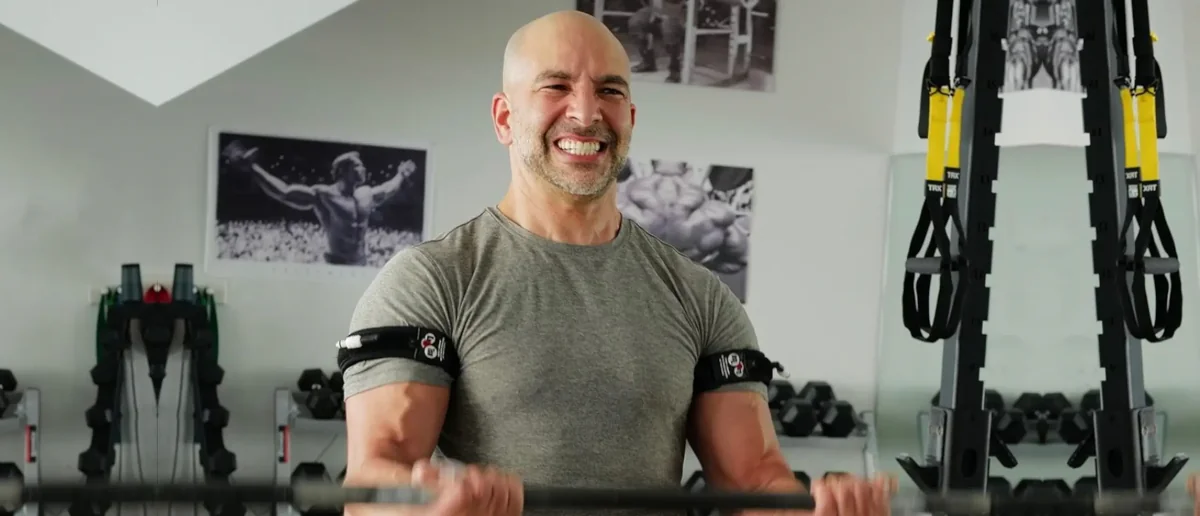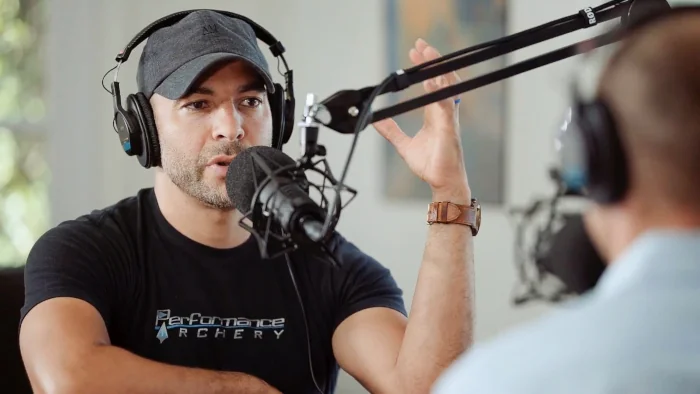Peter Attia is the founder of Early Medical and a well-known practitioner in longevity medicine and lifestyle adjustments.
Beyond his achievements in medicine, he’s also an accomplished athlete, one of 721 people to complete the grueling challenge of swimming the channel between Santa Catalina and Los Angeles. The total distance covered in this swim is a minimum of 31.6 km (19.6 miles).

That’s in the range of a 10-hour swim if you’re really giving it some.
The LA Times did a write-up here. Peter stopped training athletically around 2016 (at ~43 years of age), and now just exercises for health and well-being.
In this short clip from an interview with Lewis Howes, Peter explains that extreme levels of exercise he was doing, as you get into your 40’s, can be detrimental your overall lifespan.
And how once he realized this, he switched his training to optimize for longevity, and what it might mean to be a kick-ass 100-year old:

In July of 2023, Peter published two AMAs (Training for The Centenarian Decathlon and Heart rate recovery, strength training, rucking, kidney function, and brain health) that dive into details on the kind of exercise and training programs that he uses, and what he believes are the most helpful nuggets of wisdom that people can employ in their own training.
In this article, we’ll be sharing these insights and breaking them down in a way that is easy for you to understand and apply.
The Four Pillars + Something Important
First and foremost, Peter believes there are four integral components of any longevity training that need to be followed:
- Zone 2 Training (moderate cardio exercise – more precisely defined below)
- Strength Training
- Vo2 Max Training (intense cardio – more precisely defined below)
- Stability Exercises
Something Important

These four taken together form the backbone of his approach to longevity training. However, Peter also emphasizes that exercise alone can’t do everything – poor sleep and poor nutrition/malnourishment can’t be fixed by exercise.
He does explain that if sleep or diet are a 6 or 7 out of 10, getting your exercise routine to a 10 out of 10 can be one of the best things you can do for your overall health.
Part of Peter’s rationale for focusing on exercise is to maximize the number of healthy years he (and others) have in later life.
The image below shows a hypothesis of how good physical fitness in earlier life translates into more healthy, active years in later life.

Peter Attia himself trains the four pillars as follows:
Zone 2
What is zone 2 cardio? Peter defines it in this video as an exercise that results in a blood lactate level of around 1.7 to 2 mmol/L. Alternatively, it’s a type of cardiovascular exercise that brings you right up to the point where talking out loud would be impossible and stays just under that.
His program is as follows:
- He does zone 2 training every Tuesday, Thursday, Saturday, and Sunday on a bike (for 45 minutes). This can be done on a stationary bike or outdoors.
- He sometimes extends his Saturday bike ride and adds an anaerobic element (peddles faster or goes up more hills, etc).

Strength Training
Peter Attia refers to strength training as a muscle’s capacity to generate force. Athletes view strength as a foundational attribute because a muscle that can generate force more easily is more efficient in anything it does.
This isn’t just beneficial to athletes but is important for the entire population. This meta-analysis showed that resistance training can improve general health, mental health, social functioning, among other benefits.

Peter goes for a simple upper body and lower body split training program four days a week. This means that a single training session is devoted to training the upper body, and then the following session is devoted to training the lower body.
- Every Monday, Wednesday, Friday, and Sunday are lifting days.
- Monday is lower body, Wednesday is upper body, and so forth.
Compound Lifts
- He focuses his training around compound lifts (lifts which use multiple muscle groups at once) and he especially favours squats, deadlifts, as well as hip hinging movements like hip-thrusters and kettlebell swings.
- While squats are commonly referred to as a lower body exercise, they load nearly every muscle in the entire body (similar to deadlifts).
Upper Body Pulls and Grip

- For the upper body, he tends to focus on pulling movements, from all angles; pull-ups for overhead pulling motions, and rows for forward pulling motions.
- He incorporates dead hangs and finger-tip pullups for grip strength.
- He mentions in many interviews that he’s always been a fan of weighted carries – specifically farmer carries (which can be done holding a dumbbell in each hand or a barbell, and loading up to anywhere from half to as close as you can get to your entire body weight).
On any days that cardio (Zone 2) and strength training overlap, he does cardio first and then strength training.
He also states that he doesn’t skip strength training days and will shuffle around cardio training if his schedule demands it.
To learn more about good quality strength training, he recommends Mark Rippetoe’s book Starting Strength.
Vo2 Max
Saturday is Peter’s official Vo2 Max training day.
Peter’s own Vo2 Max protocols vary, but he likes to do 4 minutes on 4 minutes off with rowing machines, or 1 minute on (for a very intense interval) and 2 minutes off on a stairmaster.
He’ll repeat this for 20 to 30 minutes.
The basic way to do Vo2 Max training is to exercise at a very intense level (approaching 90 to 100 percent of max heart rate) for 3 – 8 minute intervals.
It’s important to allow your heart rate to recover more completely between Vo2 Max intervals. Peter emphasizes this is not HIIT (High Intensity Interval Training) where rests are quite brief.
You have to rest long enough to be able to sustain your intervals for around 20 to 30 minutes.
Why is Vo2 max important?
Vo2 max represents our peak aerobic capability. Specifically, the maximum rate at which our heart, lungs, and muscles can effectively use oxygen.
Generally, younger people have a high Vo2 max, and elderly people have a low one.
The reason that this factors heavily into longevity is that our Vo2 max declines with age, and below a certain threshold we transition from independent living to dependent living.
The graph below illustrates the benefits of having a higher Vo2 max early in life and maintaining it as you age. There’s a big gap in physical capability between 75-year-olds who are high fitness vs low fitness. For example, it could be the difference between climbing stairs comfortably or not.

How to measure your Vo2 Max?
Vo2 max is measured as milliliters of oxygen used in one minute per kilogram of body weight (ml/min/kg).
The standard test for it involves a device that measures your oxygen and CO2 output and is performed in a lab setting on a treadmill or stationary bike.
So, your first option for measuring Vo2 max is to find a clinic that offers this test. With costs in the region of $100-$150.

Stability Training
Peter believes that stability training is very important and neglected – he refers to it as a “foundational pillar.” He trains it every day, usually in ten minute sessions.
Stability training is your bodies ability to efficiently handle and transmit force, many muscle and joint injuries are caused by both weak stabilizer muscles and poor movement patters – this is what stability training attempts to address.
Peter himself prefers to use a system known as Dynamic neuromuscular stabilization (DNS).
DNS is a system that retrains movement patterns to more natural states. For example, younger children tend to naturally have much better stability in their movement patterns.
Pilates and postural exercises can also be great stability training methods.
The Minimum Effective Training Dose

While the minimum amount of exercise depends on someone’s fitness goals, Peter Attia offers a program for someone who is not engaging in any exercise at all.
Spreading training over 3 hours a week he recommends:
- 1 hour of Zone 2 Steady State
- 1 hour of strength training
- A single 20 – 30 minute Vo2 Max training session as outlined above
- 30 – 40 minutes of stability training spread across the week (ideally reaching 10 minutes every day).
What Exercise Equipment Does Peter Attia Recommend?
Peter Attia states that while it’s nice to have access to a trainer and a full gym, not everyone has the luxury of it.
He recommends everyone invest in a few pieces of equipment:
- Cheap adjustable-weight dumbbells (heavy enough to challenge you in weighted carries)
- Kettlebells (heavy enough to challenge you – usually 16kg to 24kg for women, and 24kg to 32kg for men)
- Resistance bands (can be a great cheap low-tech strength training option)
- TRX suspension straps (helpful for both strength and stability training exercises)
Peter Attia on Injury Prevention

Peter recommends that a one-size-fits-all approach does not work for a lot of people. It’s better to work with a movement therapist who deeply understands your injury.
He believes that a nagging injury shouldn’t be ignored, as it can quickly turn more serious and completely alter how you move, which would then limit strength development in that area.
While rehabilitation can take time, it’s far better to tackle a small injury before it gets bigger.
For more serious injuries, he’s reluctant to offer recommendations and believes that the best route is to be a more discerning “consumer of your care” or shop around for physiotherapists who are best qualified/take the time to understand your injury and its history.
Final Words
Peter Attia’s workout routine covers everything you need to have well-balanced physical fitness. It’s important to note that Peter believes everyone should be their own coach, he encourages people to experiment and find what works for them.
I’ve also written about Peter’s supplements and diet:
If you’ve got any questions or comments, please leave them below.
Lastly, this seems like a good opportunity to mention Peter’s subscription service – with which I have zero affiliation – but am enthusiastic about.
For an annual fee, it gives you access to his detailed show notes & “Qualys” series, which are short (<10 minute) highlights from the back catalog of podcasts.
This is a great way to support Peter’s continued time spent on the podcast, as well as make sure you’re getting all the latest and greatest info.


